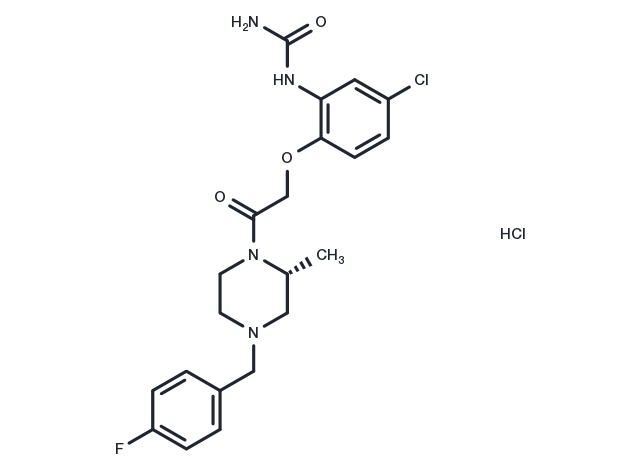Powder: -20°C for 3 years | In solvent: -80°C for 1 year


BX471 hydrochloride (ZK-811752 hydrochloride) is a potent, selective non-peptide CCR1 antagonist (Ki: 1 nM for human CCR1). It shows 250-fold selectivity for CCR1 over CCR2, CCR5, and CXCR4.

| Description | BX471 hydrochloride (ZK-811752 hydrochloride) is a potent, selective non-peptide CCR1 antagonist (Ki: 1 nM for human CCR1). It shows 250-fold selectivity for CCR1 over CCR2, CCR5, and CXCR4. |
| Targets&IC50 | MIP-1α-CCR1:1 nM (ki), MCP-3-CCR1:5.5 nM (ki), RANTES-CCR1:2.8 nM (ki) |
| In vitro | BX471 is a potent functional antagonist based on its ability to inhibit a number of CCR1-mediated effects including Ca2+ mobilization, increase in extracellular acidification rate, CD11b expression, and leukocyte migration and it is also able to displace 125I-MIP-1α/CCL3 binding to mouse CCR1 in a concentration-dependent manner (Ki: 215 nM). BX471 demonstrates a greater than 10,000-fold selectivity for CCR1 compared with 28 G-protein-coupled receptors [1]. BX471 also inhibits the RANTES-mediated adhesion of T lymphocytes to activated endothelium [4]. BX471 (0.1-10 μM) shows dose-dependent inhibition of RANTES-mediated and shear-resistant adhesion on IL-1β-activated microvascular endothelium in shear flow in isolated blood monocytes. Increasing concentrations of BX471 inhibits the Ca2+ transients induced by MIP-1α/CCL3 in both human and mouse CCR1 (IC50s: 5.8 nM and 198 nM) [2]. |
| In vivo | BX471 demonstrates a marginally significant impact on the quantity of CCR5-positive CD8 cells in peripheral blood and notably decreases FSP1-positive cells in UUO kidneys by 65% compared to the vehicle control, highlighting its efficacy [2]. Administered orally or intravenously at 4 mg/kg, it shows a bioavailability of 60% in dogs, indicating good oral activity. Moreover, BX471 significantly mitigates symptoms in a rat model of experimental allergic encephalomyelitis, which is a model for multiple sclerosis [1], illustrating its potential therapeutic benefits. At a dosage of 20 mg/kg subcutaneously, it reaches a peak plasma concentration of 9 μM within 30 minutes, but this level sharply falls to roughly 0.4 μM after 2 hours, and declines further to 0.1 μM or less from 4 to 8 hours post-administration. In mice, a 10-day treatment with BX471 at 20 mg/kg results in a 55% reduction in interstitial CD45 positive leukocytes, demonstrating its anti-inflammatory properties. Additionally, pretreatment with BX471 effectively reduces macrophage and neutrophil build-up in the kidney following ischemia-reperfusion injury [3], showcasing its potential in protecting renal function from injury-induced inflammation. |
| Synonyms | ZK-811752 hydrochloride |
| Molecular Weight | 471.35 |
| Formula | C21H25Cl2FN4O3 |
| CAS No. | 288262-96-4 |
Powder: -20°C for 3 years | In solvent: -80°C for 1 year
DMSO: 150 mg/mL (318.23 mM), Sonication is recommended.
You can also refer to dose conversion for different animals. More
bottom
Please see Inhibitor Handling Instructions for more frequently ask questions. Topics include: how to prepare stock solutions, how to store products, and cautions on cell-based assays & animal experiments, etc.
BX471 hydrochloride 288262-96-4 Others ZK 811752 Hydrochloride BX471 Hydrochloride ZK811752 Hydrochloride BX 471 Hydrochloride ZK-811752 Hydrochloride BX-471 hydrochloride BX-471 Hydrochloride ZK-811752 hydrochloride inhibitor inhibit
